
Among the many natural wonders that call Yellowstone National Park home, there’s a bubbling hot spring that researchers have recently discovered has a very special ability. Known as the Doublet Pool, the hydrothermal pool lets out a bold thump every 20 to 30 minutes, vibrating the near-boiling water and the ground around it.
As per a new study, this regular vibration acts like a “thumping thermometer” that reflects how much energy is heating the pool at the bottom.
Doublet Pool is found in the Upper Geyser Basin of Yellowstone and is about the size of half a tennis court, filled with piping water that runs around 2.4 meters (8 feet) deep. Its notorious pulses are the result of bubbles in the plumbing system that feeds it water, heated by the superhot magma that pulses beneath Yellowstone.
In other hot springs, this process can create a geyser of hot water and steam erupting from the pool. However, water isn’t able to build pressure in the Doublet Pool, so no such eruption occurs – instead, it simply rings out with a thump.
In this latest research, scientists found that the rate of the thumps varied from year to year, day to day, and even hour to hour. For instance, the interval of silence between thumps was around 30 minutes in November 2016, then just 13 minutes in September 2018, before rising to 20 minutes in November 2021.
Intrigued, the team sought to understand what was causing this variation. In doing so, they hope to gain some knowledge about the wider hydrothermal fluxes of Yellowstone
“We knew Doublet Pool thumps every 20-30 minutes, but there was not much previous knowledge on what controls the variation. In fact, I don’t think many people actually realize the thumping interval varies. People pay more attention to geysers,” Fan-Chi Lin, study co-author and an associate professor in the department of geology and geophysics at the University of Utah, said in a statement.
“By studying Doublet Pool, we are hoping to gain knowledge on the dynamic hydrothermal processes that can potentially be applied to understand what controls geyser eruptions, and also less predictable and more hazardous hydrothermal explosions,” Lin added.
They think it all boils down to heat transfer. In November 2016, when the silence interval of the pool’s thumps was very short, Ear Spring on the nearby Geyser Hill erupted for the first time since 1957. Following the activity, the water in Doublet Pool increased.
This incident showed how heat under Geyser Hill may have been turned up the heat under Doublet Pool in this instance. In other words, hydrothermal heating at the base of the pool was influencing the rate of thumps.
As a side note, this is a hell of a lot of heat: Lin explains that it would take over 100 household furnaces to burn enough heat up to create a thump from Doublet Pool.
Just as the pool’s base is significant, heat transfer at the water’s surface also may play a role. By looking at weather conditions and the pool’s activity, they found that wind speed over the pools was correlated with the silence interval. Although this process isn’t fully understood, they speculate it’s a bit like blowing on a hot coffee to cool it down.
“Right now, we are treating the pool as one whole system, which means energy taken away from the surface makes it harder for the system to accumulate enough energy to thump,” Lin explained. “One possibility is that the pool is actively convecting so the cooling near the surface can affect the bottom of the pool in a relatively short time scale.”
The new study was published in the journal Geophysical Research Letters.
Source Link: Yellowstone's Searing-Hot Pulsing Pool Acts Like A Thumping Thermometer